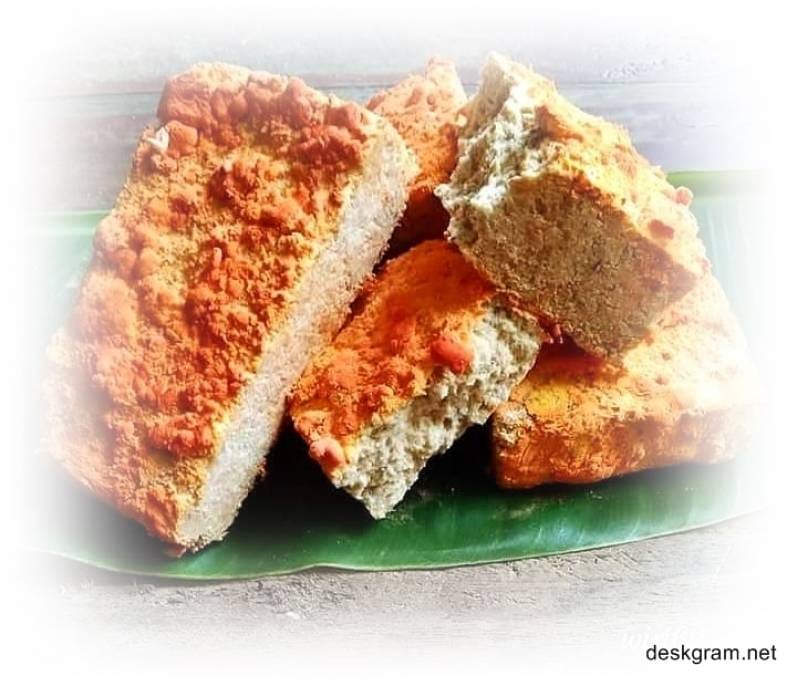Since it is actually a by-product, this food is typically a lot cheaper than most food production. Although it is high in nutrient content, not many people like this food due to its pungent aroma or uninteresting color, shape, or appearance.
HOW THIS FOOD IS MADE
The process of making this unique food is basically similar to tempe, however, there are some additional steps to make. The first step is soaking the peanut press cake to separate the fat from the press cake. Next, lactic acid is added to provide ideal pH for the fermentation process, which is 4.5 the soaked press cake is then pressed to remove the water, excess fat, and dirt.
Next, it is cooked with tapioca, soy pulp, and coconut while constantly stirred and let it boiled for 45-90 minutes. Then, let it cool down and add the mold culture. Pour it into a bamboo container covered with banana leaves. However, don’t cover it too tightly. The ideal fermentation temperature is 27-370C. Once this unique food ready, you can cook it before serving it as dishes.
NUTRIENT CONTENT
This unique dish is indeed cheap as it is made of by-products of other food processing. However, this food is high in nutrition content especially high in protein and low in fat which makes it an alternative protein source of protein. A side from protein, this food also high in genistein, a form of isoflavone. As we all know, isoflavone is great for its antioxidant activity, and thus may reduce the risk of cancer.
Aside from the two important nutrients above, this unique food also contain other beneficial compounds. Some of them are fat, carbohydrates, calcium, phosphorus, and iron. The nutrient content in this food proves that this unique food is a cheaper alternative for other more expensive, healthy foods.
BENEFITS OF THIS UNIQUE FOOD
Fermented foods have always known to have a positive benefit for health. This unique dish, as one of the fermented foods known in West Java Indonesia also packed with nutrients that may help to improve your overall health. Below are some of the benefits of consuming this unique food.
1. Reducing cholesterol level; Similar to tahu and tempe, this dish also proved to have the ability to lower the cholesterol level. A study in 2000 suggests that this fermented food is significantly lower plasma cholesterol. This is because of the protein, isoflavone, and dietary fiber content in this fermented food.
2. Anti-cancer properties; As mentioned above, this fermented food contains genistein, a type of isoflavone which known to have antioxidant activity. This unique delicacies contains a lot of genistein and therefore may have anti-cancer activity and other positive biological effects. In fact, although have less vitamin C, the ethanol extract of this food shows anti-cancer property against breast cancer cells.
3. Promote the immune system; A recent study found that this dish also promotesthe immune system. It also promotes the cytokine produced by the macrophage cells. This is because of the upregulation of the cytokines gene expression.
4. Prevent flatulence; The fermentation process can prevent flatulence. This is because the alpha-galactosidase enzyme helps to turn the raffinose and stachia into a lower level. This process prevents gas formation in the gut that causes flatulence.
HOW TO SERVE THIS DISH
Due to its pungent aroma, this unique dish is very rarely to be served raw as it is. Usually, it is deep-fried in palm oil, or as a mixture for sambal or Indonesian hot sauce. Sometimes, it is also used as fillings for other popular food named comro, or as a mixture for other soupy food.
Another alternative to serve this unique food is by stir-fried it with other ingredients. You only need to prepare some oncom and slice it into smaller parts, chilly, shallots, garlic, tomato, basil leaves, soy sauce, salt, sugar, water, and palm oil. Then, heat a little bit oil in a pan on medium heat, and then add sliced chilly, shallots, and garlic until it smells pleasant.
Next, add the main ingredients and stir it evenly, add seasonings such as soy sauce, salt, sugar, a little bit water, and stir well. After it is mixed well, add sliced tomatoes and basil leaves, and serve.
In West Java Indonesia itself, this unique dish is not really well-utilized into daily dishes. It is rarely used although oncom is actually has a big potential as a protein source for middle to lower class due to its generally more affordable price. However, due to its uninteresting presentation and cheaper price, it is also not really attract many people.



